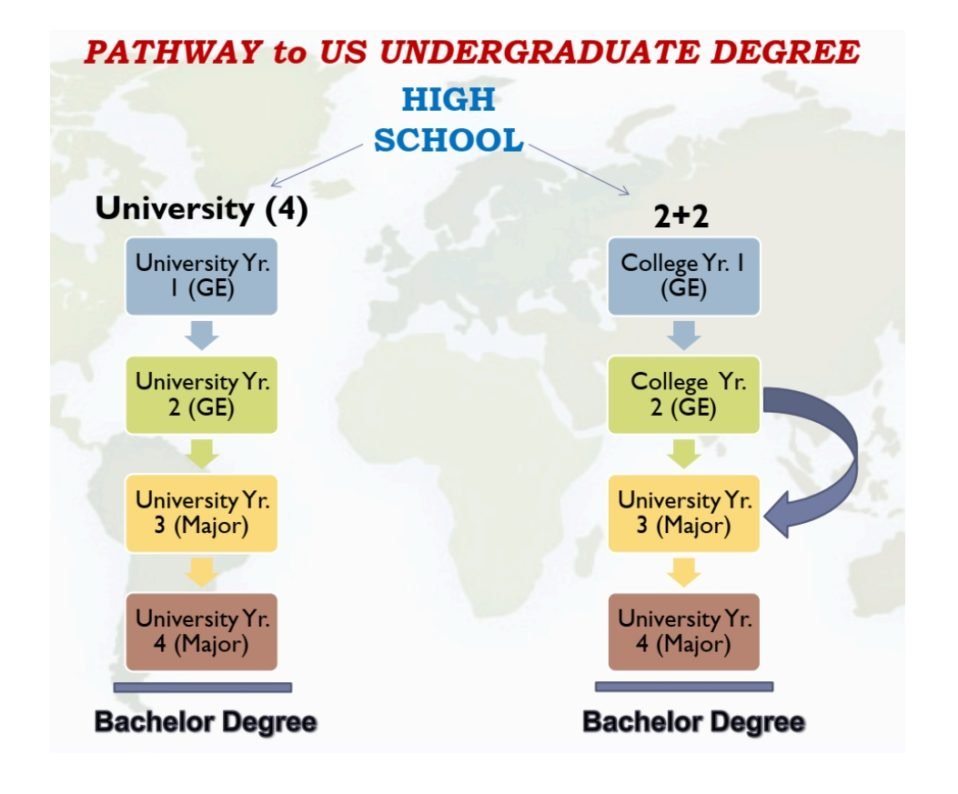Your cart is currently empty!
The College System in the USA
After completing K-12 education, students in the United States can pursue various options for higher education:
-

- Community Colleges
- Offer 2-year associate degree programs.
- Affordable and often serve as a pathway to transfer to 4-year universities.
- Popular for students seeking cost-effective education or specialized vocational training.
- Four-Year Colleges and Universities
- Grant bachelor’s degrees in arts, sciences, business, engineering, and more.
- Include public universities (state-funded) and private institutions.
- Public universities typically have lower tuition fees for in-state students.
- Liberal Arts Colleges
- Focus on undergraduate education in arts, humanities, and sciences.
- Offer smaller class sizes and a broad-based curriculum.
- Specialized Institutions
- Focus on specific disciplines like art, music, business, or technology.
- Examples include Rhode Island School of Design (RISD) and Massachusetts Institute of Technology (MIT).
- Community Colleges
Popular Career Options for Students
Students in the U.S. can pursue careers across diverse fields:
- STEM Fields (Science, Technology, Engineering, Mathematics): Software Engineering, Biotechnology, Data Science, etc.
- Business and Management: Finance, Marketing, Entrepreneurship.
- Healthcare: Medicine, Nursing, Public Health.
- Social Sciences: Psychology, Political Science, Sociology.
- Creative Arts: Graphic Design, Film Production, Writing.
- Law and Policy: Pre-Law, International Relations, Public Administration.
Exams Required for College Admissions
Admission requirements depend on the institution and program. Commonly required exams include:
- SAT: A standardized test assessing math, evidence-based reading, and writing.
- ACT: Covers English, math, reading, science, and an optional writing section.
- TOEFL/IELTS: For non-native English speakers to demonstrate English language proficiency.
- Advanced Placement (AP) Exams: Optional but can strengthen applications and earn college credits.
- Subject-Specific Tests: Required for programs like medicine or engineering (e.g., MCAT, GRE).
Tuition Fees in U.S. Colleges
Tuition fees vary widely based on the type of institution and residency status:
- Community Colleges: $3,000–$10,000 per year.
- Public Universities:
- In-State: $10,000–$25,000 per year.
- Out-of-State: $25,000–$40,000 per year.
- Private Universities: $35,000–$75,000 per year.
Note: These estimates exclude additional costs like housing, books, and meals.
Top 20 Colleges and Universities in the USA (Undergraduate Programs)
- Princeton University (NJ)
- Massachusetts Institute of Technology (MIT) (MA)
- Stanford University (CA)
- Harvard University (MA)
- California Institute of Technology (Caltech) (CA)
- University of Chicago (IL)
- University of Pennsylvania (PA)
- Yale University (CT)
- Columbia University (NY)
- Duke University (NC)
- Northwestern University (IL)
- Johns Hopkins University (MD)
- Dartmouth College (NH)
- Brown University (RI)
- Vanderbilt University (TN)
- Rice University (TX)
- University of Notre Dame (IN)
- University of California, Berkeley (CA)
- University of California, Los Angeles (UCLA) (CA)
- University of Michigan, Ann Arbor (MI)
Why Choose the USA for Higher Education?
- Global Recognition: Degrees from U.S. institutions are highly valued worldwide.
- Diverse Opportunities: Access to cutting-edge research, internships, and global networking.
- Flexible Education System: Freedom to explore different fields before declaring a major.
Ready to take the first step toward your dream of studying in America? Explore our resources for admission tips, test preparation materials, and career counseling. Your future begins here!






